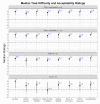Wheeled Mobility Use on Accessible Fixed-Route Transit: A Field Study in Environmental Docility
- PMID: 33802242
- PMCID: PMC8001639
- DOI: 10.3390/ijerph18062840
Wheeled Mobility Use on Accessible Fixed-Route Transit: A Field Study in Environmental Docility
Abstract
Multiple field studies provide qualitative accounts of usability barriers experienced by users of wheeled mobility devices on public transit. This study aimed to examine these usability barriers from the theoretical perspective of Environmental Docility by quantifying the relationship between functional capabilities of wheeled mobility device users and ingress-egress performance on accessible fixed-route transit vehicles in an urban setting. Twenty-eight wheeled mobility users each completed three trips on a predetermined route through the local public transit system. Ingress and egress times, user-reported usability ratings and open-ended comments were analyzed. Regression analyses indicated significant interactions between age and minimum parallel-park length on ingress and egress times. Specifically, lower functional capability reflected in older age and less maneuvering ability predicted decreased performance (longer ingress-egress times), indicating less adaptability to environmental demands and agreement with the Environmental Docility Hypothesis. Usability ratings and comments revealed difficulty with negotiating access ramps and turning maneuvers in the vehicle interior and in proximity to other passengers. Despite compliance with accessibility standards, current design of transit vehicles present substantial usability barriers for wheeled mobility users. Environmental Docility provides a theoretical basis to identifying modifiable factors related to person and environment for improving usability of public transit for people aging and/or with mobility impairments.
Keywords: accessibility; environmental docility; public transit; usability; wheeled mobility.
Conflict of interest statement
The authors declare no conflict of interest.
Figures





Similar articles
-
Self-reported difficulty and preferences of wheeled mobility device users for simulated low-floor bus boarding, interior circulation and disembarking.Disabil Rehabil Assist Technol. 2019 Feb;14(2):109-121. doi: 10.1080/17483107.2017.1401128. Epub 2017 Nov 13. Disabil Rehabil Assist Technol. 2019. PMID: 29130752 Free PMC article.
-
Retrospective review of adverse incidents involving passengers seated in wheeled mobility devices while traveling in large accessible transit vehicles.Med Eng Phys. 2010 Apr;32(3):230-6. doi: 10.1016/j.medengphy.2009.01.004. Epub 2009 Apr 22. Med Eng Phys. 2010. PMID: 19395304
-
A systematic review of public transport accessibility for people using mobility devices.Disabil Rehabil. 2021 Aug;43(16):2253-2267. doi: 10.1080/09638288.2019.1697382. Epub 2019 Dec 4. Disabil Rehabil. 2021. PMID: 31800337
-
Effects of transit bus interior configuration on performance of wheeled mobility users during simulated boarding and disembarking.Appl Ergon. 2017 Jul;62:94-106. doi: 10.1016/j.apergo.2017.02.008. Epub 2017 Feb 27. Appl Ergon. 2017. PMID: 28411744
-
Anthropometry and standards for wheeled mobility: an international comparison.Assist Technol. 2010 Spring;22(1):51-67. doi: 10.1080/10400430903520280. Assist Technol. 2010. PMID: 20402047 Review.
Cited by
-
Incidence and dynamics of mobility device use among community-dwelling older adults in the United States.J Elder Policy. 2024 Oct;3(2):70-94. doi: 10.1002/jey2.12011. Epub 2024 Sep 25. J Elder Policy. 2024. PMID: 40708911 Free PMC article.
References
-
- United Nations Convention on the Rights of Persons with Disabilities: Article 9—Accessibility. [(accessed on 8 January 2021)]; Available online: https://www.un.org/development/desa/disabilities/convention-on-the-right....
-
- US Department of Justice The Americans with Disabilities Act of 1990 and Revised ADA Regulations (15 September 2010) [(accessed on 22 November 2020)]; Available online: https://www.ada.gov/2010_regs.htm.
-
- Steinfeld A., Maisel J.L., Steinfeld E. Accessible Public Transporation: Designing Service for Riders with Disabilities. Taylor & Francis/Routledge; Boca Raton, FL, USA: 2018.
Publication types
MeSH terms
Grants and funding
LinkOut - more resources
Full Text Sources
Other Literature Sources
Medical

